Assessment of Lightweight Concrete Properties with Zinc Oxide Nanoparticles: Structural and Morphological Analyses
Abstract
1. Introduction
- Nanoparticles provide a seeding surface for the deposition of hydrates and therefore facilitate the hydration of OPC and mineral admixtures.
- Nano-SiO2 and other nano-clays increase pozzolanic reactivity, thus increasing the production of cementitious phases, most notably, C-S-H.
- Nanoparticles fill gaps among larger particles and modify nano and micro-scale density.
- The high cost of nanoparticles in comparison with other concrete components.
- Changes in the flowability and set times of OPC products, although this may be a benefit in some applications.
- High variability in OPC products with nanoparticles.
2. Materials and Methods
2.1. Lightweight Concrete (LWC) Mixtures
- The coarse aggregate was saturated with water for 24 h before being mixed.
- Dry cement and dry sand were mixed for 30 s at 140 rpm.
- ZnO nanoparticles were incorporated into the dry mixture and mixed for 30 s at 140 rpm.
- Water and saturated coarse aggregate were added, and all the components were mixed for 60 s at 140 rpm.
- The LWC mixtures were mixed for 90 s more at the same velocity (140 rpm)
- The fresh LWC specimens were poured into molds.
2.2. Characterization Techniques
2.2.1. Compressive Strength Testing
2.2.2. Morphological and Compositional Characterization Techniques
3. Results and Discussion:
3.1. Compressive Strength Results
3.2. Statistical Analyses
3.2.1. Z-Score Method
3.2.2. Tukey’s Method
- Definition of the Inter Quartile Range (IQR). IQR is the distance between the lower (Q1) and the upper (Q3) quartiles.
- Definition of inner fences following Equations (3) and (4):
3.3. Morphological and Compositional Characterizations of Samples
4. Conclusions
- -
- The manufacturing process developed in this work provided a very homogeneous distribution of nanoparticles in LWC.
- -
- The use of ZnO nanoparticles delays the curing process by several days. Seven extra days are needed in this process to reach structural mechanical properties.
- -
- The incorporation of nanoparticles as a cement substitute significantly reduces the compressive strength of LWC. Percentages of ZnO nanoparticles above 1 wt% cannot be classified as structural LWC.
- -
- ZnO incorporation by addition provides structural LWC with a compressive strength above 20 MPa when added in percentages up to 1.5 wt%.
- -
- There is no morphological difference between the two methods of incorporation of ZnO nanoparticles. The morphological characteristics are very similar and independent of the method of incorporation and the ratio of nanoparticle/cement.
Author Contributions
Funding
Institutional Review Board Statement
Informed Consent Statement
Data Availability Statement
Acknowledgments
Conflicts of Interest
References
- Feynman, R. There’s plenty of room at the bottom (Reprint from speech given at annual meeting of the American Physical Society). Eng. Sci. 1960, 23, 22–36. [Google Scholar]
- Armarego, W.L.F. Nanomaterials. In Purification of Laboratory Chemicals; Butterworth-Heinemann: Oxford, UK, 2022; pp. 586–630. [Google Scholar] [CrossRef]
- Sanchez, F.; Sobolev, K. Nanotechnology in concrete—A review. Constr. Build. Mater. 2010, 24, 2060–2071. [Google Scholar] [CrossRef]
- Federowicz, K.; Techman, M.; Sanytsky, M.; Sikora, P. Modification of Lightweight Aggregate Concretes with Silica Nanoparticles—A Review. Materials 2021, 14, 4242. [Google Scholar] [CrossRef] [PubMed]
- Reches, Y. Nanoparticles as concrete additives: Review and perspectives. Constr. Build. Mater. 2018, 175, 483–495. [Google Scholar] [CrossRef]
- Huseien, G.F. A Review on Concrete Composites Modified with Nanoparticles. J. Compos. Sci. 2023, 7, 67. [Google Scholar] [CrossRef]
- Farzadnia, N.; Abang Ali, A.A.; Demirboga, R. Characterization of high strength mortars with nano alumina at elevated temperatures. Cem. Concr. Res. 2013, 54, 43–54. [Google Scholar] [CrossRef]
- Iskra-Kozak, W.; Konkol, J. The Impact of Nano-Al2O3 on the Physical and Strength Properties as Well as on the Morphology of Cement Composite Crack Surfaces in the Early and Later Maturation Age. Materials 2021, 14, 4441. [Google Scholar] [CrossRef]
- Oltulu, M.; Şahin, R. Single and combined effects of nano-SiO2, nano-Al2O3 and nano-Fe2O3 powders on compressive strength and capillary permeability of cement mortar containing silica fume. Mater. Sci. Eng. A 2011, 528, 7012–7019. [Google Scholar] [CrossRef]
- Hamidi, F.; Aslani, F. TiO2-based Photocatalytic Cementitious Composites: Materials, Properties, Influential Parameters, and Assessment Techniques. Nanomaterials 2019, 9, 1444. [Google Scholar] [CrossRef]
- Gopalan, A.-I.; Lee, J.-C.; Saianand, G.; Lee, K.-P.; Sonar, P.; Dharmarajan, R.; Hou, Y.-L.; Ann, K.-Y.; Kannan, V.; Kim, W.-J. Recent Progress in the Abatement of Hazardous Pollutants Using Photocatalytic TiO2-Based Building Materials. Nanomaterials 2020, 10, 1854. [Google Scholar] [CrossRef]
- Bica, B.O.; De Melo, J.V.S.; Gleize, P.J.P. Photocatalytic Concrete Blocks Nanomodified with Zinc Oxide for Paving: Mechanical Performance and Microstructural Characteristics. J. Test. Eval. 2021, 49, 2860–2884. [Google Scholar] [CrossRef]
- Liu, J.; Jin, H.; Gu, C.; Yang, Y. Effects of zinc oxide nanoparticles on early-age hydration and the mechanical properties of cement paste. Constr. Build. Mater. 2019, 217, 352–362. [Google Scholar] [CrossRef]
- Le Pivert, M.; Poupart, R.; Capochichi-Gnambodoe, M.; Martin, N.; Leprince-Wang, Y. Direct growth of ZnO nanowires on civil engineering materials: Smart materials for supported photodegradation. Microsyst. Nanoeng. 2019, 5, 57. [Google Scholar] [CrossRef] [PubMed]
- Amor, F.; Baudys, M.; Racova, Z.; Scheinherrová, L.; Ingrisova, L.; Hajek, P. Contribution of TiO2 and ZnO nanoparticles to the hydration of Portland cement and photocatalytic properties of High Performance Concrete. Case Stud. Constr. Mater. 2022, 16, e00965. [Google Scholar] [CrossRef]
- Tan, J.; Sierens, Z.; Vandevyvere, B.; Dan, H.; Li, J. Zinc oxide in alkali-activated slag (AAS): Retardation mechanism, reaction kinetics and immobilization. Constr. Build. Mater. 2023, 371, 130739. [Google Scholar] [CrossRef]
- Goyal, R.; Verma, V.K.; Singh, N. Effect of nano TiO2 & ZnO on the hydration properties of Portland cement. Mater. Today Proc. 2022, 65, 1956–1963. [Google Scholar] [CrossRef]
- Zhang, M.; Du, L.; Li, Z.; Xu, R. Durability of marine concrete doped with nanoparticles under joint action of Cl- erosion and carbonation. Case Stud. Constr. Mater. 2023, 18, e01982. [Google Scholar] [CrossRef]
- Soto-Felix, M.; Baldenebro-Lopez, F.J.; Carreño-Gallardo, C.; Herrera-Ramirez, J.M. Hybrid Cements with ZnO Additions: Hydration, Compressive Strength and Microstructure. Molecules 2022, 27, 1278. [Google Scholar] [CrossRef] [PubMed]
- Garg, R.; Garg, R. Effect of zinc oxide nanoparticles on mechanical properties of silica fume-based cement composites. Mater. Today Proc. 2021, 43, 778–783. [Google Scholar] [CrossRef]
- CEN EN 206: 2013; Concrete—Specification, Performance, Production and Conformity. European Committee for Standardization: Brussels, Belgium, 2013.
- Iyer, N.R. An overview of cementitious construction materials. In New Materials in Civil Engineering; Elsevier: Amsterdam, The Netherlands. [CrossRef]
- Bozorgmehr Nia, S.; Nemati Chari, M. Applied development of sustainable-durable high-performance lightweight concrete: Toward low carbon footprint, durability, and energy saving. Results Mater. 2023, 20, 100482. [Google Scholar] [CrossRef]
- Wang, X.F.; Huang, Y.J.; Wu, G.Y.; Fang, C.; Li, D.W.; Han, N.X.; Xing, F. Effect of nano-SiO2 on strength, shrinkage and cracking sensitivity of lightweight aggregate concrete. Constr. Build. Mater. 2018, 175, 115–125. [Google Scholar] [CrossRef]
- ASTM C109; Standard Test Method for Compressive Strength of Hydraulic Cement Mortars. ASTM International: West Conshohocken, PA, USA, 2009; Volume 80.
- Rabanal, F.P.Á.; del Coz Díaz, J.J.; Alonso-Martinez, M.; Martínez, J.E.M. Thermal and structural optimization of lightweight concrete mixtures to manufacture composite slabs. In Proceedings of the International Conference on Mechanical Models in Structural Engineering—CMMoST, Alicante, Spain, 23–25 October 2019; pp. 657–667. [Google Scholar]
- EN 12390-2:2020; Testing Hardened Concrete. Part 2: Making and Curing Specimens for Strength Tests. European Committee for Standardization: Brussels, Belgium, 2020.
- EN 12390-4:2019; Testing Hardened Concrete Compressive Strength. Specification for Testing Machines. European Committee for Standardization: Brussels, Belgium, 2019.
- EN 12390-3; Testing Hardened Concrete. Part 3: Compressive Strength of Test Specimens. European Committee for Standardization: Brussels, Belgium, 2019.
- Seo, S. A Review and Comparison of Methods for Detecting Outliers in Univariate Data Sets. Master’s Thesis, University of Pittsburgh, Pittsburgh, PA, USA, 2006. [Google Scholar]
- Shiffler, R.E. Maximum Z Scores and Outliers. Am. Stat. 1988, 42, 79–80. [Google Scholar] [CrossRef]


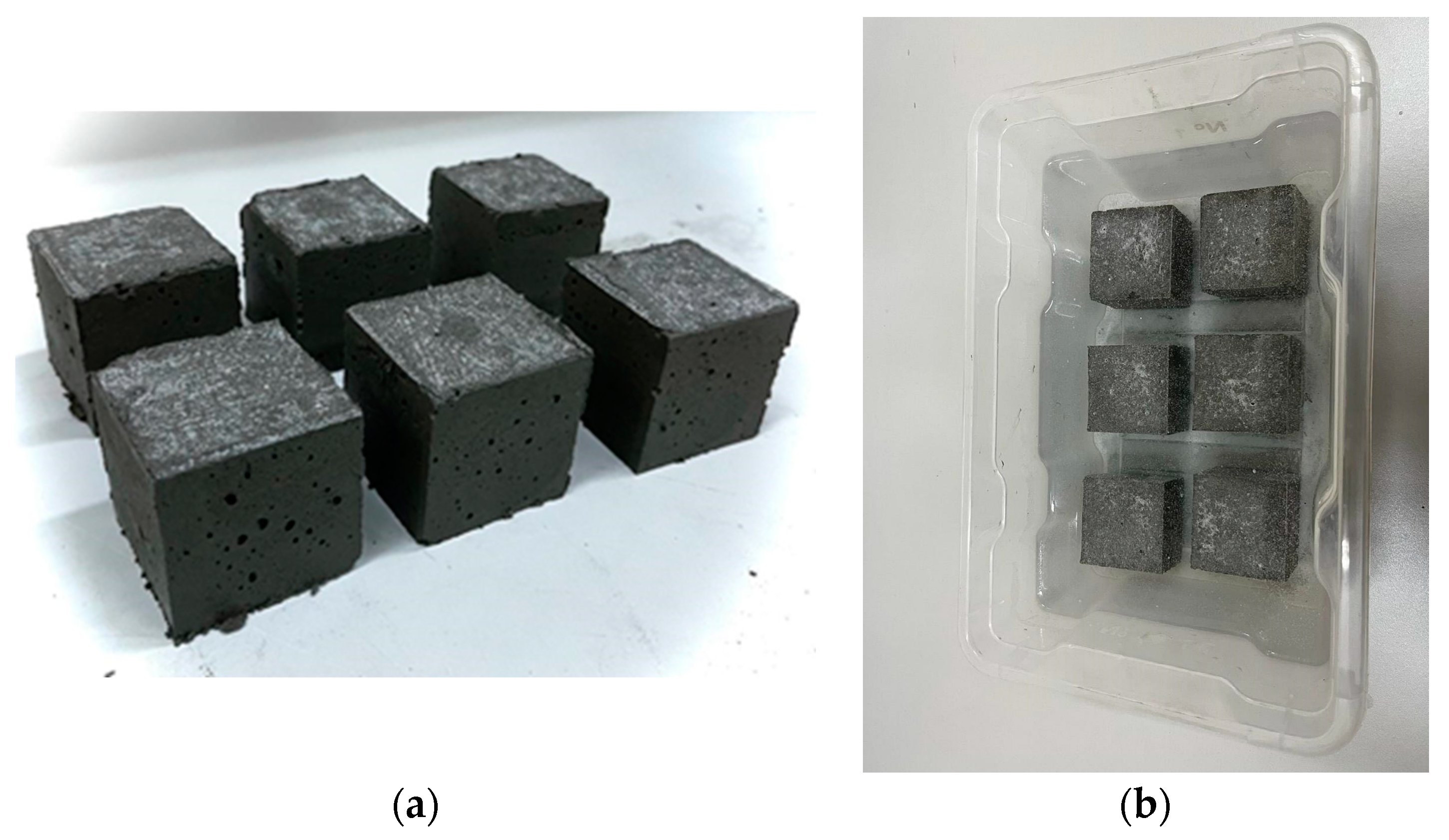
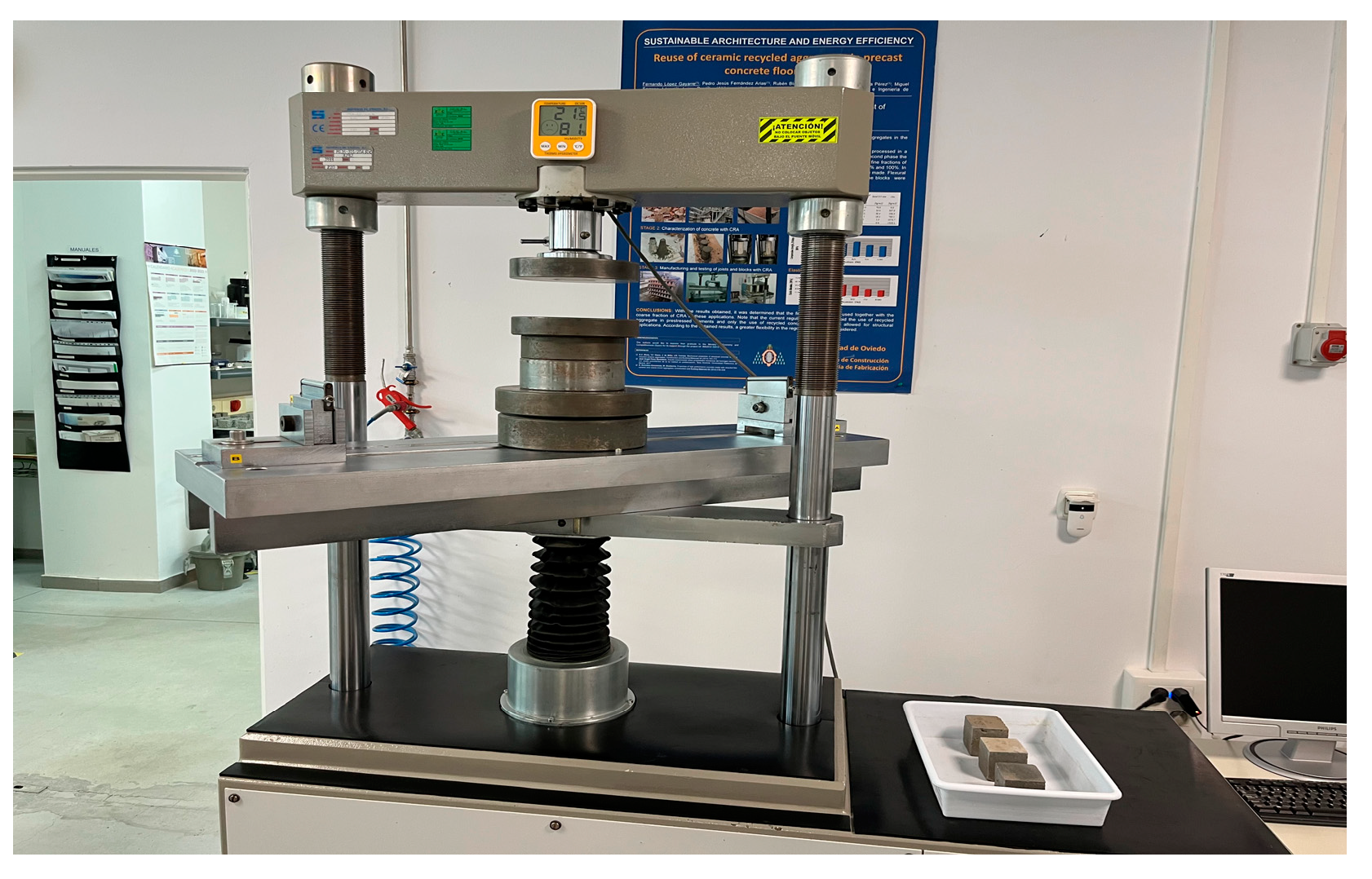

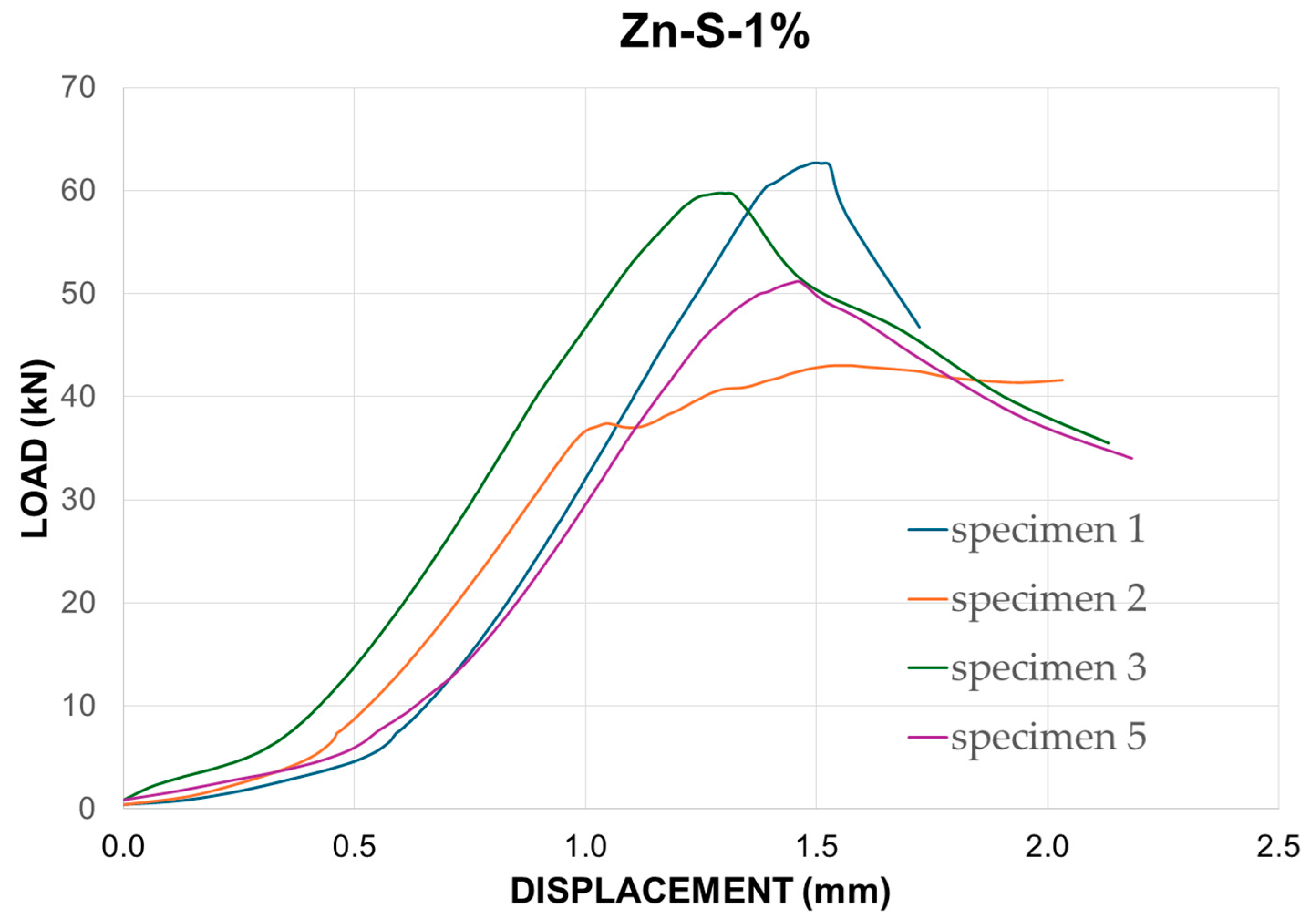
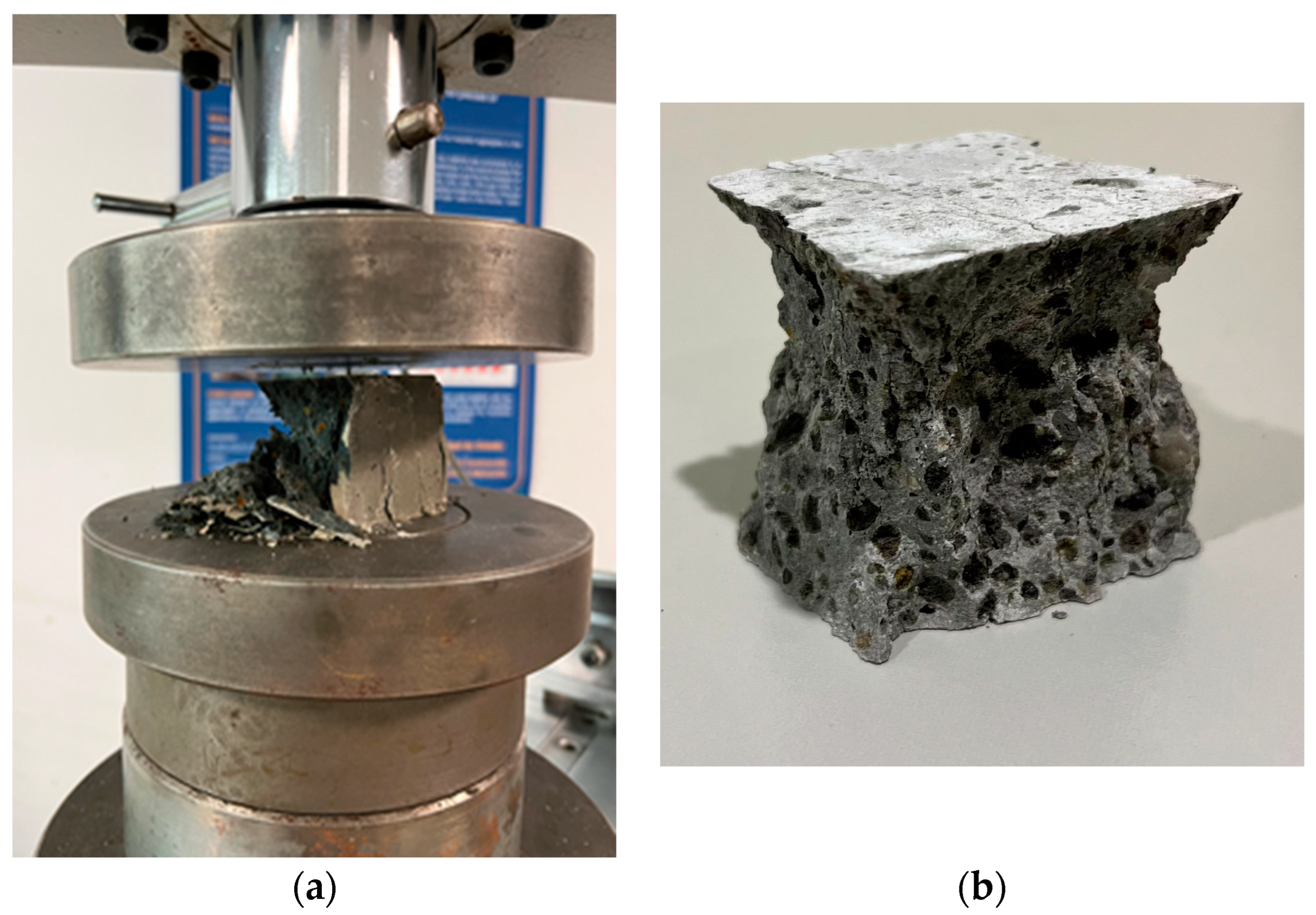
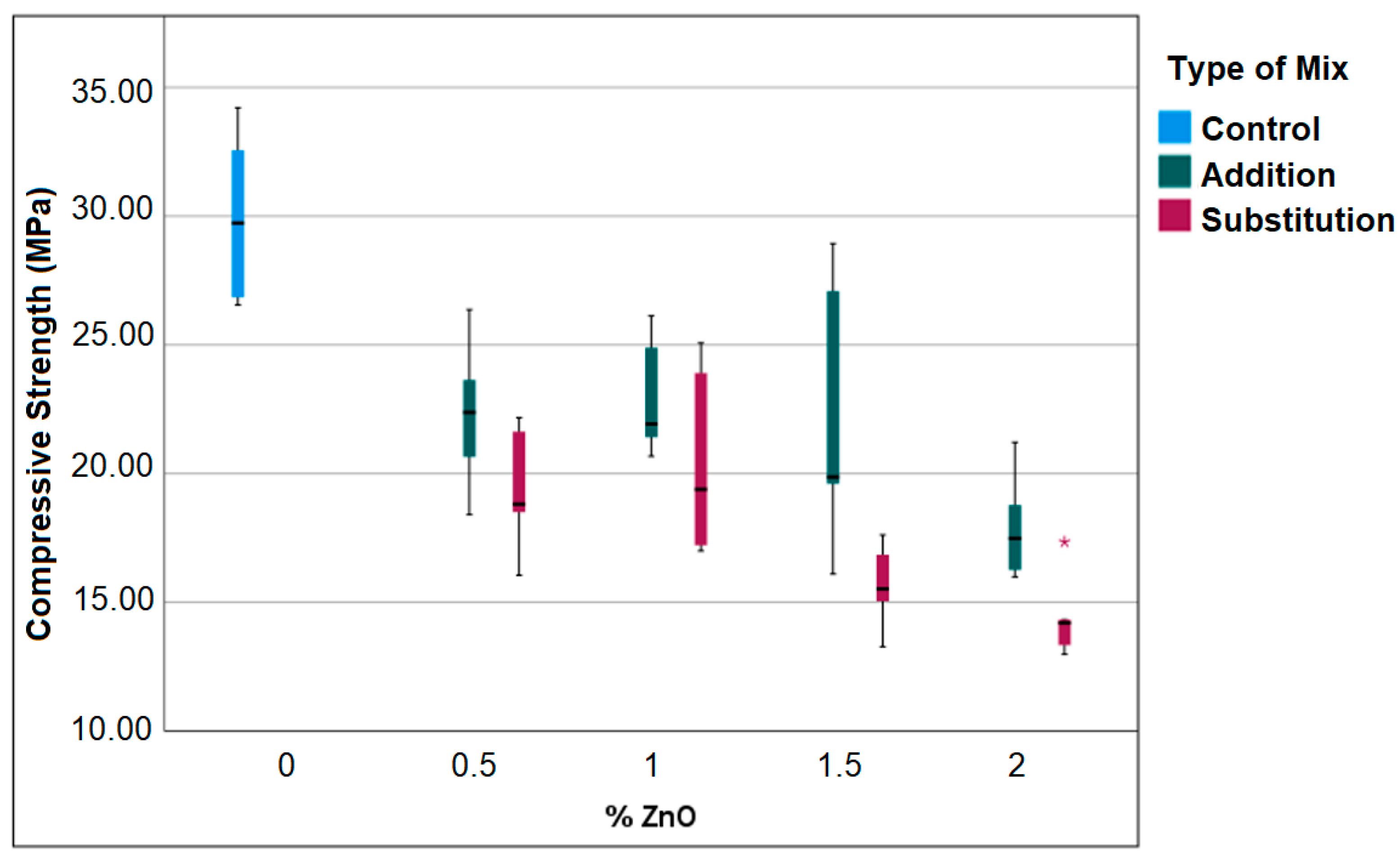
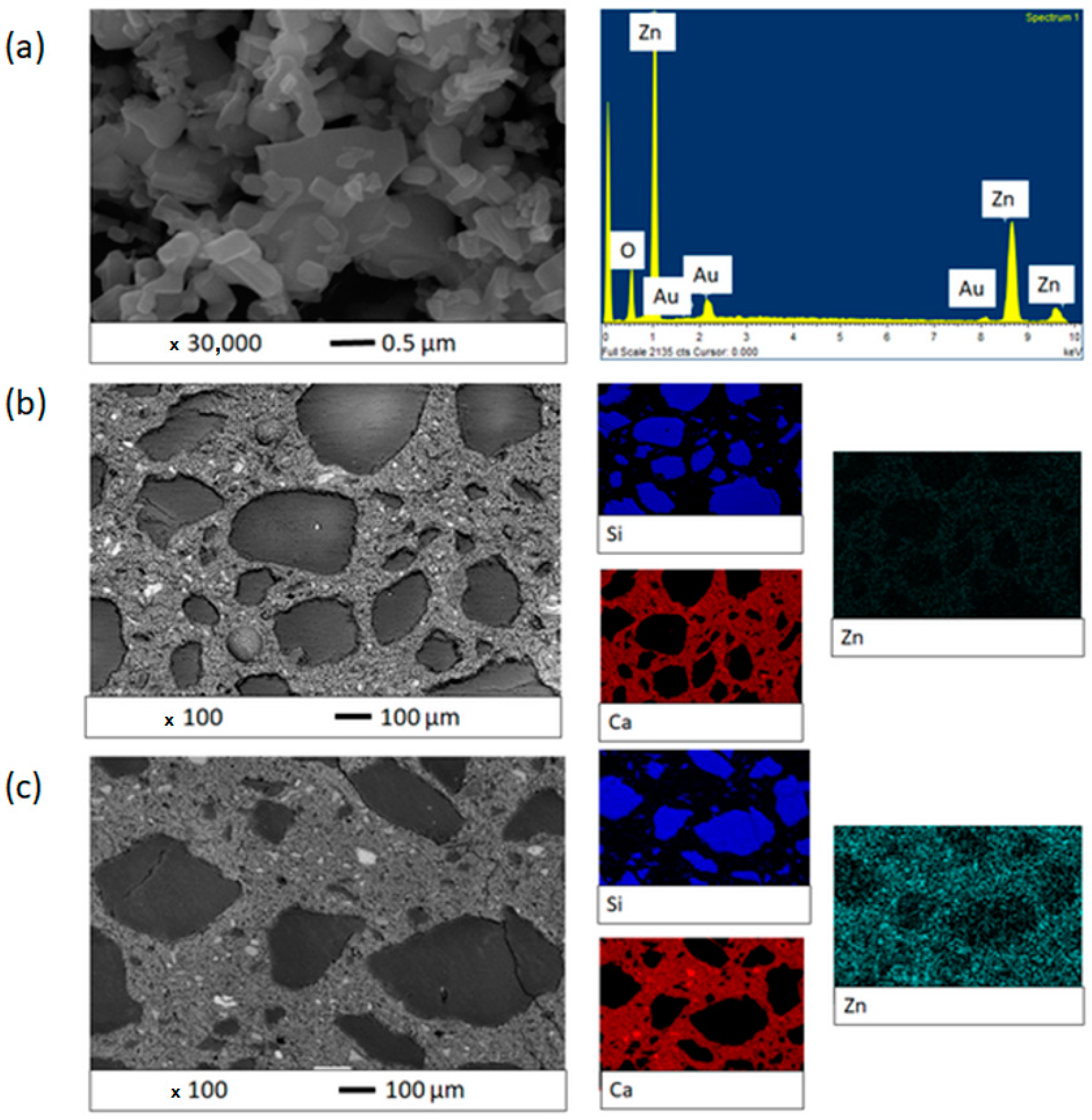
| Mix | Cement (g) | Sand (g) | Coarse Aggregate (Leca-Dur) (g) | Coarse Aggregate Leca-S (g) | Water (g) | ZnO (g) |
|---|---|---|---|---|---|---|
| LWC_control | 338.43 | 425.49 | 61.57 | 63.78 | 135.37 | 0 |
| Zn-S-0.5 | 336.74 | 425.49 | 61.57 | 63.78 | 135.37 | 1.69 |
| Zn-S-1.0 | 335.04 | 425.49 | 61.57 | 63.78 | 135.37 | 3.38 |
| Zn-S-1.5 | 333.35 | 425.49 | 61.57 | 63.78 | 135.37 | 5.08 |
| Zn-S-2.0 | 331.66 | 425.49 | 61.57 | 63.78 | 135.37 | 6.77 |
| Zn-A-0.5 | 338.43 | 425.49 | 61.57 | 63.78 | 135.37 | 1.69 |
| Zn-A-1.0 | 338.43 | 425.49 | 61.57 | 63.78 | 135.37 | 3.38 |
| Zn-A-1.5 | 338.43 | 425.49 | 61.57 | 63.78 | 135.37 | 5.08 |
| Zn-A-2.0 | 338.43 | 425.49 | 61.57 | 63.78 | 135.37 | 6.77 |
| Element | Content |
|---|---|
| Zinc oxide | ≥99.9% |
| Pb | ≤0.005% |
| Cd | ≤0.003% |
| Fe | ≤0.001% |
| Cu | ≤0.001% |
| Weight loss at 105 °C | ≤0.2% |
| Weight loss at 825 °C | ≤0.3% |
| Water soluble matter | ≤0.02% |
| Insoluble matter in triammonium liquor | ≤0.01% |
| Properties | Value |
|---|---|
| Specific surface | 4.0–6.0 |
| Real density | 5.67 |
| Apparent density | 0.7–1.0 |
| Sieve reject 45 μm | ≤0.01% |
| Type of Mix | Specimen 1 | Specimen 2 | Specimen 3 | Specimen 4 | Specimen 5 | Specimen 6 |
|---|---|---|---|---|---|---|
| LWC_control | 32.56 | 34.21 | 26.55 | 26.85 | 29.15 | 30.32 |
| Zn-S-0.5 | 21.63 | 22.17 | 18.81 | 16.05 | 18.50 | 18.83 |
| Zn-S-1.0 | 25.08 | 18.31 | 23.91 | 17.00 | 20.47 | 17.22 |
| Zn-S-1.5 | 16.85 | 15.04 | 16.00 | 13.28 | 17.62 | 15.04 |
| Zn-S-2.0 | 14.33 | 14.25 | 12.98 | 14.15 | 17.35 | 13.34 |
| Zn-A-0.5 | 23.64 | 26.37 | 22.58 | 18.41 | 20.65 | 22.19 |
| Zn-A-1.0 | 21.42 | 21.77 | 26.13 | 24.89 | 20.68 | 22.09 |
| Zn-A-1.5 | 28.94 | 27.09 | 16.10 | 20.09 | 19.65 | 19.61 |
| Zn-A-2.0 | 18.35 | 16.26 | 21.22 | 18.78 | 16.62 | 15.99 |
| Type of Mix | Specimen 1 | Specimen 2 | Specimen 3 | Specimen 4 | Specimen 5 | Specimen 6 |
|---|---|---|---|---|---|---|
| LWC_control | 0.85 | 1.39 | 1.10 | 1.01 | 0.25 | 0.12 |
| Zn-S-0.5 | 1.02 | 1.26 | 0.23 | 1.45 | 0.37 | 0.22 |
| Zn-S-1.0 | 1.36 | 0.58 | 1.03 | 0.95 | 0.03 | 0.90 |
| Zn-S-1.5 | 0.79 | 0.39 | 0.24 | 1.53 | 1.29 | 0.39 |
| Zn-S-2.0 | 0.04 | 0.09 | 0.92 | 0.16 | 1.91 | 0.69 |
| Zn-A-0.5 | 0.49 | 1.51 | 0.10 | 1.44 | 0.61 | 0.04 |
| Zn-A-1.0 | 0.65 | 0.49 | 1.52 | 0.95 | 0.99 | 0.34 |
| Zn-A-1.5 | 1.41 | 1.04 | 1.17 | 0.36 | 0.46 | 0.46 |
| Zn-A-2.0 | 0.24 | 0.81 | 1.68 | 0.45 | 0.63 | 0.94 |
| Type of Mix | Lower Limit | Upper Limit |
|---|---|---|
| LWC_control | 20.56 | 38.86 |
| Zn-S-0.5 | 15.04 | 24.46 |
| Zn-S-1.0 | 9.16 | 31.39 |
| Zn-S-1.5 | 12.64 | 19.03 |
| Zn-S-2.0 | 12.39 | 15.46 |
| Zn-A-0.5 | 17.53 | 26.89 |
| Zn-A-1.0 | 17.48 | 28.21 |
| Zn-A-1.5 | 11.04 | 33.92 |
| Zn-A-2.0 | 12.87 | 22.15 |
Disclaimer/Publisher’s Note: The statements, opinions and data contained in all publications are solely those of the individual author(s) and contributor(s) and not of MDPI and/or the editor(s). MDPI and/or the editor(s) disclaim responsibility for any injury to people or property resulting from any ideas, methods, instructions or products referred to in the content. |
© 2024 by the authors. Licensee MDPI, Basel, Switzerland. This article is an open access article distributed under the terms and conditions of the Creative Commons Attribution (CC BY) license (https://creativecommons.org/licenses/by/4.0/).
Share and Cite
Gonzalez Garcia, A.S.; Silva Klein, L.T.; Vega Martinez, V.; Alonso Martinez, M.; del Coz-Díaz, J.J. Assessment of Lightweight Concrete Properties with Zinc Oxide Nanoparticles: Structural and Morphological Analyses. Appl. Sci. 2024, 14, 4413. https://doi.org/10.3390/app14114413
Gonzalez Garcia AS, Silva Klein LT, Vega Martinez V, Alonso Martinez M, del Coz-Díaz JJ. Assessment of Lightweight Concrete Properties with Zinc Oxide Nanoparticles: Structural and Morphological Analyses. Applied Sciences. 2024; 14(11):4413. https://doi.org/10.3390/app14114413
Chicago/Turabian StyleGonzalez Garcia, Ana Silvia, Luis Tomas Silva Klein, Victor Vega Martinez, Mar Alonso Martinez, and Juan José del Coz-Díaz. 2024. "Assessment of Lightweight Concrete Properties with Zinc Oxide Nanoparticles: Structural and Morphological Analyses" Applied Sciences 14, no. 11: 4413. https://doi.org/10.3390/app14114413
APA StyleGonzalez Garcia, A. S., Silva Klein, L. T., Vega Martinez, V., Alonso Martinez, M., & del Coz-Díaz, J. J. (2024). Assessment of Lightweight Concrete Properties with Zinc Oxide Nanoparticles: Structural and Morphological Analyses. Applied Sciences, 14(11), 4413. https://doi.org/10.3390/app14114413








